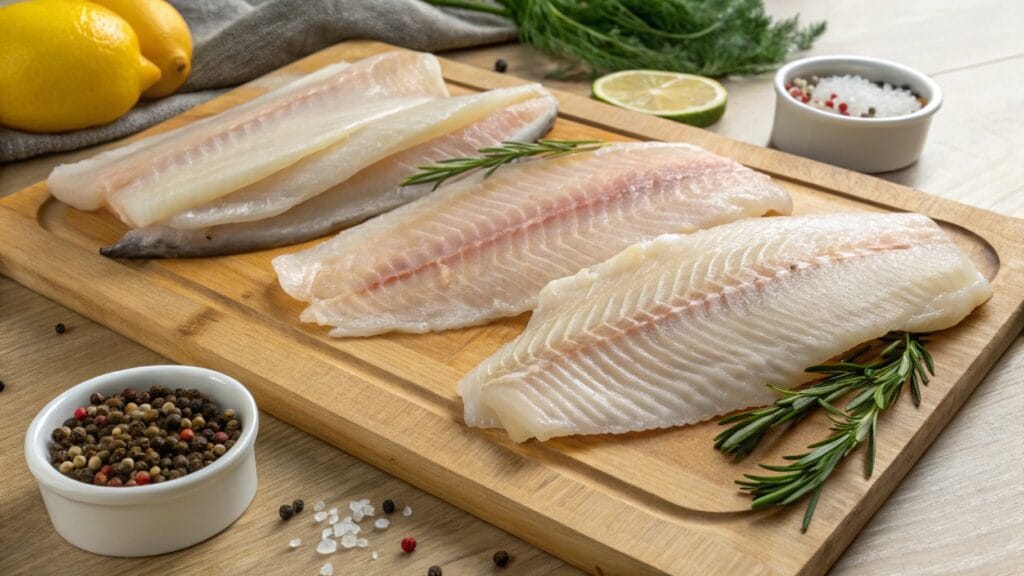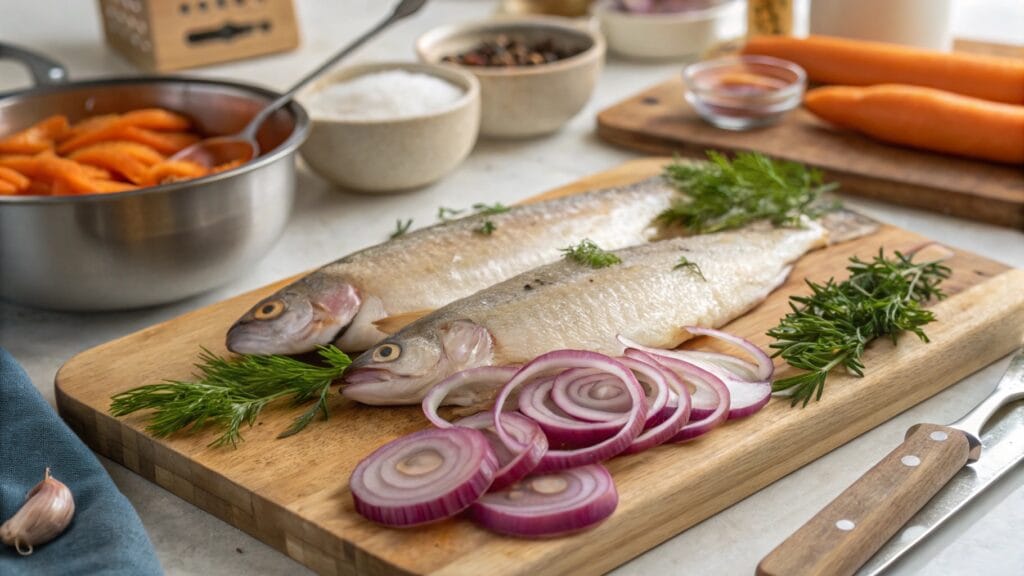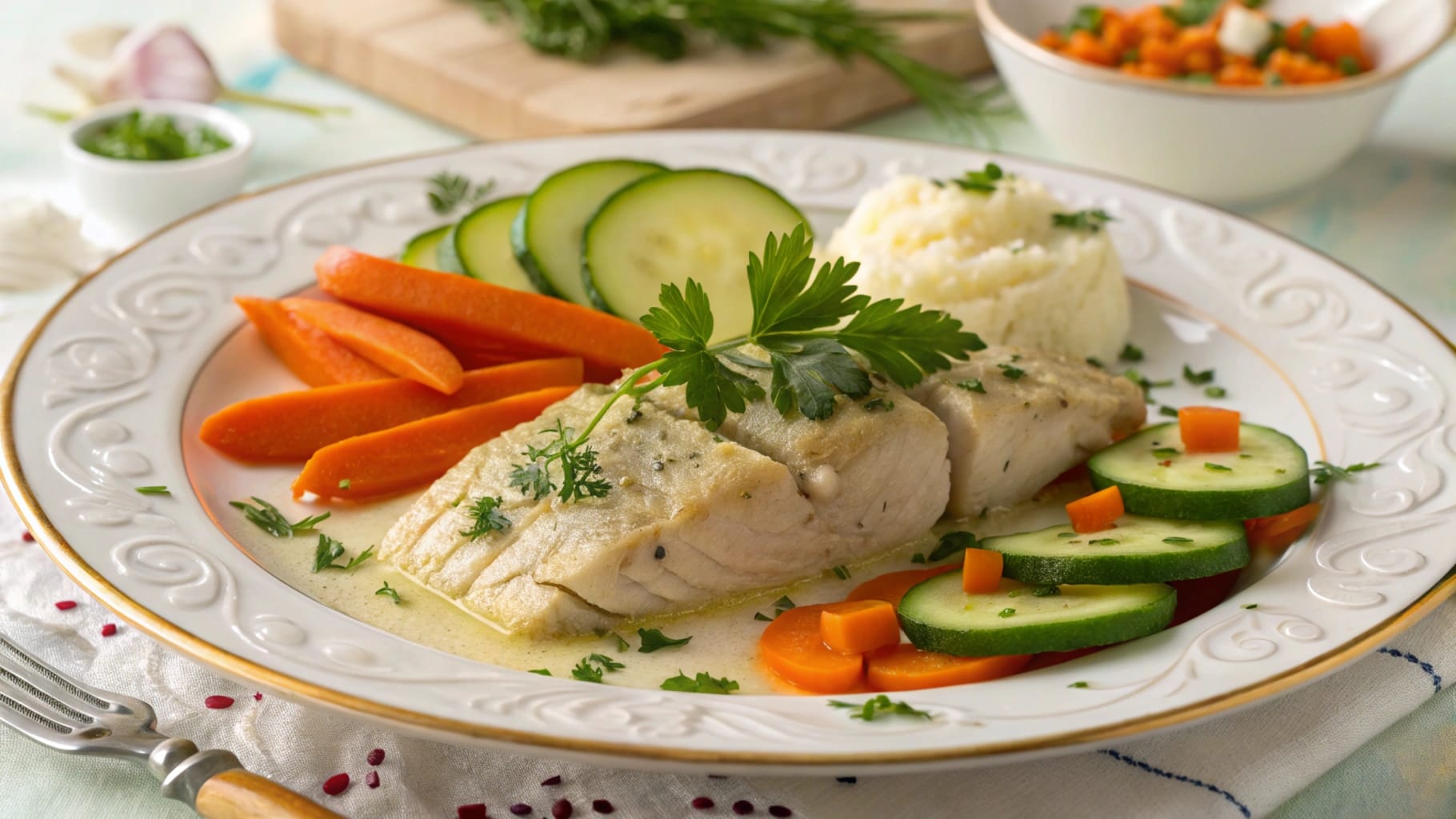Gefilte fish recipe” is a staple of Jewish cuisine, often found at family gatherings and special occasions. This classic gefilte fish recipe combines fresh fish, aromatic vegetables, and a delicate blend of seasonings that create a dish bursting with flavor.
Table of contents
What is Gefilte Fish? Understanding the Classic Jewish Dish
Gefilte fish is often described as “fish patties” or “fish loaves,” and it’s typically made from ground fish, often a mix of white fish like carp, pike, and whitefish. The word “gefilte” comes from the Yiddish term meaning “stuffed,” which gives us a hint about its origins: centuries ago, people would stuff fish with fillings, and over time, that evolved into the ground fish version we know today.
In essence, gefilte fish is a dish that’s shaped by centuries of tradition, and it’s especially popular during Jewish holidays like Passover and Shabbat. The fish is traditionally poached in a flavorful broth and served cold, often with a dollop of horseradish for an extra kick.
History of Gefilte Fish: A Tradition Passed Down
Gefilte fish has been around for a long time. In fact, it dates back to the Middle Ages, when Jewish communities in Eastern Europe would catch and use fish from nearby rivers and lakes. In those days, whole fish were expensive and sometimes hard to prepare, so people began grinding the fish into a paste and mixing it with other ingredients, such as matzo meal or breadcrumbs, to make it more affordable and stretch it further.
This dish has been an important part of Jewish cuisine for generations. And even though it might have a somewhat “old-fashioned” reputation, it’s still an essential part of Jewish holiday meals. It’s said that when Jewish people were living in the shtetls (small towns) in Eastern Europe, gefilte fish was a way to make the best of what you had, using inexpensive fish and creating something rich in flavor and texture.
What Makes Gefilte Fish Unique?
What makes gefilte fish stand out from other fish dishes is its texture. It’s dense yet delicate, moist but firm. Some might even say it has a somewhat “meatball-like” quality to it because of how it holds together after being poached. But that’s also part of its charm. Unlike other fish dishes, where you might find chunks of fish, gefilte fish has a smooth and cohesive texture that you can easily slice.
It’s also not just a “fish dish.” It’s a comfort food, a tradition, and a symbol of family and togetherness. And, if you’ve never had it before, be ready to experience something that feels a little nostalgic, even if you’re trying it for the first time.
Essential Ingredients for the Perfect Gefilte Fish Recipe
The beauty of gefilte fish lies in its simplicity. With just a few key ingredients, you can create a dish that’s delicious, satisfying, and steeped in tradition.

Fish Selection: Choosing the Best Fish for Gefilte Fish
The type of fish you use is absolutely crucial for a successful gefilte fish recipe. Traditionally, carp, pike, and whitefish are the most common choices. Each of these has a firm texture and mild flavor, which makes them ideal for grinding into a paste and holding up well during cooking.
- Carp: This is probably the most traditional fish used in gefilte fish. It’s hearty, and its slightly oily texture helps keep the fish moist.
- Pike: Known for its slightly firmer texture and mild flavor, pike adds an interesting depth to gefilte fish.
- Whitefish: This fish is mild in flavor and flaky in texture, perfect for creating a light and airy gefilte fish mixture.
You can often find pre-ground fish at your local Jewish deli or grocery store, but if you want to get the freshest possible results, try grinding the fish yourself using a food processor. This will give you full control over the texture.
Traditional vs. Modern Ingredients: What You Need
While the base ingredients remain the same, some cooks choose to adapt the recipe to suit modern tastes or dietary restrictions. Here are the most common ingredients for classic gefilte fish:
| Ingredient | Quantity |
|---|---|
| Ground whitefish, pike, or carp | 2 pounds |
| Onion, finely chopped | 1 medium |
| Eggs | 2 large |
| Matzo meal | 1/2 cup |
| Carrots, grated | 1 medium |
| Salt | 1 teaspoon |
| Sugar | 1 teaspoon |
| Pepper | 1/2 teaspoon |
| Fish stock (or water) | 4 cups |
| Fresh parsley (optional) | 1 tablespoon |
Some people might also use breadcrumbs instead of matzo meal for a different texture or flavor. For a more modern twist, you can experiment with adding ingredients like garlic, lemon zest, or even fresh herbs like dill for a refreshing, contemporary version.
Are There Any Substitutes for the Traditional Ingredients?
Absolutely! Not everyone has access to traditional fish types like carp, pike, or whitefish, so don’t worry if you can’t find them at your local grocery store. Instead, you can substitute with tilapia, cod, or bass—fish that have a mild flavor and firm texture. However, do keep in mind that using a leaner fish like tilapia might affect the final texture, making it slightly drier.
For those with dietary restrictions, gluten-free matzo meal is available and can be used in place of regular matzo meal. If you’re trying to avoid eggs, you can use a combination of ground flaxseed and water as a binder. The beauty of gefilte fish is that it’s quite flexible—just don’t stray too far from the essential flavor profile, and you’ll still end up with a dish that tastes amazing!
How to Prepare Gefilte Fish from Scratch: A Detailed Recipe
Now that you know what makes gefilte fish special, let’s dive into the step-by-step process of creating this delicious dish. Don’t worry—it’s easier than it sounds, and the results are definitely worth the effort!

Step 1: Preparing the Fish Mixture
First, you’ll need to grind your fish (unless you’ve bought it pre-ground). If you’re grinding your own fish, use a food processor to achieve a fine, smooth consistency. You can also ask your fishmonger to grind it for you, but make sure it’s a fine grind, not chunky.
In a large bowl, combine the ground fish with chopped onions, matzo meal, and eggs. Add the grated carrots (this is what gives gefilte fish its subtle sweetness) along with the salt, sugar, pepper, and any other optional seasonings. Mix everything together thoroughly—be careful not to overmix, as this can affect the texture and make the fish too dense. You want to achieve a light, fluffy mixture that holds together well.
Step 2: Shaping the Gefilte Fish Balls or Loafs
Once your fish mixture is ready, it’s time to shape it. Traditionally, gefilte fish is formed into oval-shaped patties or loaves. Wet your hands slightly to prevent sticking, then scoop about 1/4 cup of the mixture and gently form it into an oval shape. If you prefer, you can also make a single loaf instead of individual patties.
Step 3: Cooking Gefilte Fish: Tips and Techniques
In a large pot, bring fish stock (or water) to a simmer. Carefully drop the gefilte fish patties or loaf into the pot. The key here is to keep the water at a simmer, not a rolling boil, to ensure that the fish cooks gently and evenly. Cover the pot, leaving a little gap for steam to escape, and let the fish simmer for about 1-1.5 hours, or until they are cooked through and firm to the touch.
Step 4: Serving and Storing Gefilte Fish
Once your gefilte fish is cooked, remove it from the pot and let it cool slightly. Traditionally, gefilte fish is served cold, so you can refrigerate it for several hours before serving. The fish is often accompanied by horseradish (or chrein) for that perfect blend of savory and spicy.
If you have leftovers (lucky you!), gefilte fish stores well in the fridge for up to 4 days. You can also freeze it for up to a month—just be sure to wrap it tightly to prevent freezer burn.
Nutrition Facts for Gefilte Fish (per 1 serving of 3 oz)
| Nutrient | Amount |
|---|---|
| Calories | 180 |
| Protein | 20g |
| Fat | 10g |
| Carbohydrates | 8g |
| Fiber | 1g |
| Sugars | 3g |
| Sodium | 400mg |
Conclusion: Why Gefilte Fish Remains a Beloved Dish Around the World
From its humble beginnings in the shtetls of Eastern Europe to being a cherished dish in Jewish homes worldwide, gefilte fish has stood the test of time. It’s not just about the flavors or the textures; it’s about tradition, family, and heritage. Whether served on Passover, Shabbat, or any family gathering, gefilte fish brings people together, evoking memories of past generations and celebrating the joy of shared meals.
Despite its sometimes controversial reputation—some people love it, others may be unfamiliar or uncertain—it has an undeniable place in the culinary landscape. And that’s because gefilte fish isn’t just food; it’s comfort, it’s community, and it’s connection.
Tradition and Comfort on the Plate
In every bite of gefilte fish, you taste the history of Jewish culture, where people have always found ways to adapt their resources to create something nourishing and meaningful. The act of preparing and enjoying gefilte fish is a connection to the past, to family, and to the generations that came before us. It represents resilience—a dish born out of necessity but now a centerpiece of holiday tables.
As we’ve explored, making gefilte fish at home is a deeply rewarding experience. With the right ingredients, a bit of patience, and the joy of sharing it with loved ones, you can recreate this timeless dish in your own kitchen. Whether you stick to tradition or experiment with creative variations, gefilte fish remains a symbol of togetherness.
Embracing Change with Modern Twists
Yet, as with all beloved dishes, the world of gefilte fish continues to evolve. We see cooks using sustainable fish, experimenting with new flavors, and adapting the recipe to accommodate modern dietary preferences like gluten-free and dairy-free options. Whether it’s a more health-conscious approach or the desire for a lighter, fresher take, gefilte fish remains adaptable, showing that food traditions can evolve while staying true to their roots.
In the end, gefilte fish’s place on the dinner table is not just about the taste but about cultural heritage, family traditions, and the stories that are shared across generations. Its ability to bring people together, whether in the kitchen or around the table, ensures that this dish will remain a cherished part of Jewish cuisine for years to come.
As you prepare your own gefilte fish, remember: it’s more than just a meal. It’s a reminder of where we come from and the bonds we share.
FAQ: Best Corned Beef Brine Recipes and Tips
Best Corned Beef Brine Recipe
A balanced brine with kosher salt, sugar, pickling spices, and curing salt provides a flavorful, tender corned beef. Simmer the ingredients, cool the brine, and refrigerate the brisket for 5-7 days,Gefilte fish recipe
Simple Corned Beef Brine Recipe
A quick brine made with water, kosher salt, sugar, black peppercorns, mustard seeds, and garlic. Bring to a boil, simmer, cool, and refrigerate the meat for 5-7 days.
Traditional Corned Beef Brine Recipe
Classic brine includes kosher salt, sugar, curing salt, garlic, pickling spices, and bay leaves for that iconic flavor. Simmer, cool, and refrigerate the brisket for 5-7 days.
Jewish Corned Beef Brine Recipe
Jewish-style brine uses extra garlic, black peppercorns, coriander, mustard seeds, and curing salt. This aromatic, savory brine is perfect for bold, flavorful corned beef.
Corned Beef Brine Calculator
A brine calculator helps you determine the right proportions of salt, sugar, and curing agents based on the weight of your brisket, ensuring perfectly brined meat.

